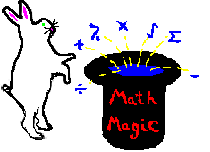 |
||
| HOME
Miscellaneous Elementary Junior High Sum Of Positive Integral Divisors High School Manipulating Polygonal Numbers
|
Working With Polynomials:A. On number sense tests you have to deal with two different types of polynomials. 1. Quadratic Equation: a. A quadratic equation is an equation in this form: ax2 + bx + c = 0. b. The sum of the roots is: -b/a c. The product of the roots is: c/a d. The discriminant is: b2 - 4ac 1. If the discriminant is positive, there are 2 real roots. 2. If the discriminant is negative, there are 0 real roots. 3. If the discriminant is zero, there is only 1 real root. 2. Polynomial of degree 3: a. A polynomial of degree 3 is in this form: ax3 + bx2 + cx + d = 0. b. The sum of the roots is: -b/a c. The product of the roots is: -d/a d. The sum of the product of the roots is: c/a (sometimes it might say taken two at a time) B. Here are some examples how the above information is used. Ex [1] The sum of the roots of 3x2 + 6x - 2 = 0 is __________. a. The sum of the roots is -b/a. b. The answer is -6/3 or -2. Ex [2] The product of the roots of x3 - 6x2 + 3x - 8 = 0 is ______. a. The product of the roots is -d/a. b. The answer is -(-8)/1 or 8. Ex [3] How many real roots does 2x2 - 3x + 4 = 0 have? ______. a. We substitute using the formula for the discriminant. b. (-3)2 - 4(2)(4) = 9 - 32 = -23. c. Since the number is negative, the equation has 0 real roots. d. The answer is 0.
|
